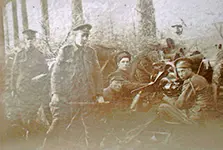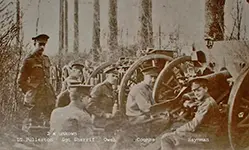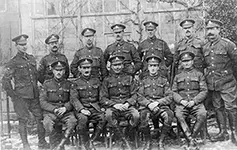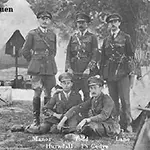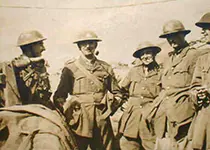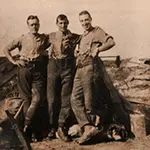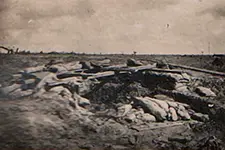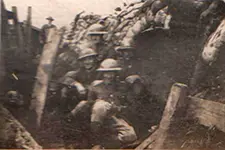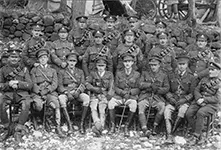240th Brigade RFA (T)
WWI History
Introduction
On the 22 November 1859, the Gloucestershire Volunteer Artillery was formed, making it's headquarters at the Artillery Ground, Whiteladies Rd. Clifton, Bristol. The unit started with five batteries with a sixth added later.
Starting in 1906, the Secretary of State for War Richard Haldane's Reforms were designed to better prepare the armed forces for future wars and involved a reorganization of the regular, volunteer and militia forces. The Territorial and Reserve Forces Act of 1907 saw the formation of the Territorial Force which consisted of fourteen infantry divisions, fourteen cavalry brigades, and a large number of support units including fully established divisions, provided with field artillery, companies of engineers and crucial supply services, including medical provision.
The Gloucestershire Volunteer Artillery became the 1st (South Midland) Brigade RFA (T) in 1908, with a further change of name in 1915 to the 240th Brigade RFA (T), under which it served throughout the First World War.
World War I
The units had just departed for their annual summer camp when war broke out in August 1914 and they were at once recalled.
1 South Midland Brigade R.F.A. (T) mobilised at Clifton and Gloucester under Lt-Col A. M. Balfour, a retired Regular officer who had been in command since 7 December 1909. it left Bristol on Saturday, August 7th. 1914 and went to its war station in the defences of the Naval base at Plymouth and Crownhill. It then joined the concentration of the South Midland Division at Broomfield, near Chelmsford, Essex by the second week of August 1914 where it formed part of Central Force and commenced training and equipping for Overseas Service.
Units of the Territorial Force (TF) were invited to volunteer for Overseas Service. On 15 August 1914, the War Office issued instructions to separate those men who had signed up for Home Service only, and form these into reserve units. On 31 August, the formation of a reserve or 2nd Line unit was authorised for each 1st Line unit where 60 per cent or more of the men had volunteered for Overseas Service. The titles of these 2nd Line units would be the same as the original, but distinguished by a '2/' prefix. In this way duplicate battalions, brigades and divisions were created, mirroring those TF formations being sent overseas.
Orders arrived on 13 March 1915, final stores and reinforcements from 2/I SM Bde arrived, and 1/I SM Bde entrained on 29 March for Southampton, where it embarked on the transports 'City of Lucknow' and 'Huanchaco', landing at Le Havre on 30 March. By 2 April the brigade reached Neuve Eglise in Belgium where the division had concentrated. The batteries took up positions assigned to them by 27 Bde of 5th Division, and began registering their guns on 5 April, despite problems with the fuzes of their old 15pdr ammunition. Lieutenant-Col Balfour of 1/I SM Bde took over tactical control of the sector from 27 Bde at midnight on 7/8 April. The brigade could do little, being allowed only 3 rounds per gun per day at first. Most of the firing was retaliatory exchanges with identified German batteries or to harass enemy working parties.
On 22 April Lt-Col Balfour left the brigade and Lt-Col Lord Wynford took over command on 9 May. On 18 May the brigade was redesignated CCXL (or 240th) Brigade[b] and the old 1/1st–1/3rd Gloucester batteries became A, B and C Btys. At the same time the recently-formed D Bty transferred to CCXLIII (6 SM) Bde in exchange for 1/4th Warwickshire Howitzer Bty, equipped with four 4.5-inch howitzers, which became D (H) Bty. The Brigade Ammunition Column (BAC) was also abolished and merged into the Divisional Ammunition Column (DA).
On 12 May the division was designated the 48th (South Midland) Division. On 26 June 1/I SM Bde was relieved by a Canadian brigade and went back to billets in Outtersteene, near Bailleul, and later to Ferfay It now formed part of a brigade group with 144th (Gloucester & Worcester) Brigade. After training, 1/I South Midland Bde went by train to Thièvres where on 21 July it was re-equipped with modern 18-pounder guns. It then went back into the line and on 31 July took over gun positions from the French at Colincamps in the Somme sector, where 48th (SM) Division joined a new Third Army.
In July, the Brigade moved south, and after a brief rest at Ferfay, entrained at Lillers for Thievres, and went into action on the plain bounded by the three villages, Hebuterne-Colincamps-Sailly-au-Bois.
During August 1/I SM Bde also had 1/3rd Worcester and 1/1st and 1/2nd Warwickshire Btys from 48th (SM) Divisional Artillery (DA) under its command, forming an artillery group under 144th Bde. It carried out some good shooting for the infantry with the new 18-pdrs. The ammunition limit was now 188 rounds per brigade per week. Some of the gun positions were frequently under water, and some were moved to obtain enfilade fire against enemy trenches. Brigade HQ was in Hébuterne, where the gunners were billeted when they were not in the line. The village was often shelled, when the batteries would retaliate on the Germans in Puisieux; they also carried out barbed wire-cutting.
This quiet routine continued into the new year, the guns remaining in position while the infantry brigades were regularly rotated out of the line for rest. 1/I South Midland Bde formed an additional battery, D Bty, at Thièvres on 29 March, including a fresh draft of men from the UK. On 31 March batteries of the newly-arrived 31st Division began taking over 1/I SM Bde's guns and positions, and on 6 April the brigade moved a short distance to Sailly, with two batteries in position in front of Serre.
After a long period of low-level Trench warfare, 48th (SM) Division's first offensive operation was in the Battle of the Somme. Both sides' artillery became more active and there were regular trench raids: A Bty was lent to 31st Division to support one raid on the night of 3/4 June. The following night CCXL (SM) Bde was relieved by CCXLIII (SM) Bde – the first time the whole brigade had been out of the line since July 1915. It moved to Coigneux, inspected its guns, and carried out training while the brigade and battery staffs reconnoitred the new positions it was to take up for the coming offensive. A, C and D Btys went into their new positions on 15 June, and work went on to improve them and to dump the ammunition (1000 rounds per gun for 18-pdrs and 800 for 4.5s). The bombardment programme for the offensive was to be spread over five days, U, V, W, X and Y before the assault was launched on Z day.
On U Day (24 June) A and B Btys began wire-cutting on the German 2nd and 3rd lines in front of Serre, while C Bty bombarded suspected observation posts (OPs) and machine gun positions and D (H) Bty shelled trench junctions and communication trenches. On W and X days C and D Bty supported VIII Corps' heavy artillery in bombarding the German 3rd line trenches. On several days the weather was too bad for good air or ground observation and the programme was extended by two days (Y1 and Y2). The battle was launched on 1 July 1916. Most of 48th (SM) Division was in reserve, only two battalions being engaged, but the brigade fired until 12.00 in support of 31st Division's assault on Serre. Despite the successful wire-cutting, not enough OPs and MG posts had been destroyed and 31stDivision's attack was a disaster: the survivors had made their way back to the British lines by the end of the day.
On July 1st they were assaulting the Quadrilateral (Heidenkopf). They were also in action at The Battle of Bazentin Ridge, capturing Ovillers, The Battle of Pozieres Ridge, The Battle of the Ancre Heights and The Battle of the Ancre. On July 21st, the Brigade moved down to Albert to support the Divisional Infantry and, except for ten days of perfect rest at St. Ouen, remained in action there until October 1st.
Orders for 48th (SM) Division to resume the attacks next day were cancelled, and over the following days the batteries ceased wire-cutting fire, concentrating on harassing enemy communications. 240 (SM) Brigade now formed part of 'A' Group of 48th (SM) DA under 242 (SM) Bde. and moved back to Coigneux. It carried out an intense bombardment for a feint attack by 48th (SM) Division on 14 July before the Battle of Bazentin Ridge. 48th (SM) Divisional Artillery came under the command of 28th Division when that took over the line next day.
Then on 21 July the gun detachments of 240 (SM) Bde travelled by bus to Aveluy to take over the guns of 12th (Eastern) Division in action there. The wagon lines were established at Bouzincourt with Brigade HQ in Aveluy Wood commanding North Group of 48th (SM) DA. This comprised C Bty and half of B Bty as a six-gun battery, together with D (H) Bty and the whole of 243 (SM) Bde; A Bty and the other half of B Bty were with South Group. At 20.30 on 23 July the guns began a four-hour bombardment, after which 48th (SM) Division put in an attack at 00.30 as part of the Battle of Pozières Ridge. The infantry of 144th Bde were mown down, but 145th (South Midland) Bde was more successful and at 06.30 it renewed its attack. Moving forward close under 'an excellent barrage', the stormers were in among the surprised Germans as soon as it lifted, and were able to secure the Ovillers–Pozières light railway and adjacent trenches.
The Brigade remained in the Hebuterne area until 21 July, 1916 - twelve months to the day after it had arrived in that area. They were soon in action in the Battle of the Somme, suffering heavy casualties. The preliminary bombardment preceding the Somme Battle, when for the first time the establishment became 1,000 rounds per gun, was the first experience of prolonged, almost continuous firing.
While 48th (SM) Division was ordered to move north of the River Ancre, its divisional artillery came under 49th (West Riding) Division. Lieutenant-Col Lord Wynford and HQ of 240 (SM) Bde took over command of the Howitzer Group, consisting of all three howitzer batteries of 48th (SM) DA and D (H)/246 Bty of 49th (WR) DA. The howitzers registered enemy trenches north of Thiepval and 49th (WR) Division's attack on 3 September succeeded in capturing 'Fabeck Graben'.
The guns continued firing on their barrage lines until 6 September when 240 (SM) Bde was withdrawn to Bouzinecourt leaving their guns in position. They returned to the line on 13 September and next day a combined group of 240 and 243 (SM) Bdes supported 32nd Bde of 11th (Northern) Division, which captured the 'Wonder Work'. Early on 15 September the whole brigade came out of action, ready to move at 2 hours' notice to follow up that day's attack (the Battle of Flers–Courcelette).
It moved up to open positions and at 18.20 opened fire in support of the Canadian Corps, which captured the village of Courcelette in the evening. As the battle continued over successive days, 48th (SM) DA was used as corps artillery to 'thicken' barrages for the attacks. On 19 September a German shell fell in brigade HQ, killing and wounding a number of officers, and HQ was moved back to 'Usna Redoubt'. The Battle of Thiepval Ridge was launched on 26 September, and the batteries fired in support of the attacks on 'Zollern Trench', 'Stuff Redoubt', 'Schwaben Redoubt', and 'Hessian Trench'. The brigade's batteries were relieved by 25th DA on the night of 29/30 September
The brigade went to quieter positions at Souastre, where it spent a few weeks carrying out registration and wire cutting shoots. On 18 October 48th (SM) DA was reorganised, with 243 Bde being broken up to bring the rest of the 18-pdr batteries up to a strength of six guns each. The brigade's former D Bty (now A/243) returned and was split between A and B Btys, while half of C/243 Bty joined C Bty.
Followed a brief return visit to the Fonquevillers-Hebuterne sector and then a return to the Somme mud-bath at the end of November - an unforgettable period in the Martinpuich area. After rest at Behancourt, the Brigade trekked to Corbie, and on February 2nd 1917, the Division relieved a French Brigade opposite Peronne.
The divisional sector continued largely quiet, though on 9 November A Bty was very heavily shelled, with one gun being destroyed. On 13 November the brigade fired to protect the flank of Fifth Army's attack on Beaumont-Hamel (the Battle of the Ancre). On 17 November 48th (SM) DA was attached to 46th (North Midland) Division for which the brigade became Right Group. On 20 November 147th (2nd West Riding) Bde of 49th (WR) Division carried out a raid on Gommecourt, for which the brigade fired a protective barrage.
On 27 November 48th (SM) DA was relieved by 49th (WR) DA, and went back to Pas, where it took over the 49th's guns, moved to Frohen-le-Grand and then on to Béhencourt by 3 December. Brigade HQ was established at Bazentin-le-Petit Cemetery. 240 (SM) Brigade remained in the one when 48th (SM) Division was relieved by 15th (Scottish) Division, and combined with 72 Bde to form South Group for 15th (S) DA. On 30 and 31 December 241 (SM) Bde's gunners relieved 240 Bde at their guns.
D (H) Battery was brought up to a strength of six howitzers when half of C (H)/242 (SM) Bty (originally 513 (H) Bty) joined on 16 January 1917. Thereafter 240 Bde had the following organisation:
A Bty + half A/243
B Bty + half A/243
C Bty + half C/243
D (H) Bty + half C (H)/242
240 (SM) Brigade was engaged in training during the first days of 1917, then on 13–14 January 1917, it relieved 242 (SM) Bde (which was leaving the division to become and Army Field Brigade) in the line west of Martinpuich, with brigade HQ at Contalmaison Villa. Although the sector was quiet, the guns continued exchanging fire with enemy batteries and suffered some damage. On 20–21 January 1917, the brigade was relieved and sending some of its guns for overhaul it went to Bayencourt.
Around mid-February the brigade moved to Flaucourt and took over positions from the French in front of Péronne. On the night of 16/17 March 144th Bde raided the enemy lines and found them empty: the Germans had begun withdrawing to the Hindenburg Line (Operation Alberich). On 18 March 48th (SM) Division liberated Péronne. 240 (SM) Brigade began moving up on 21 March, C and D (H) Btys crossing the River Somme with the division's mobile force, the rest of the brigade preparing to advance at short notice.
On 25 March D (H) Bty assisted the cavalry in clearing Tincourt Wood, and next day C and D (H) Btys cooperated with 1/4th Oxfordshire and Buckinghamshire Light Infantry and the Indian Cavalry in the capture of Roisel. On 27 March they worked with cavalry and horse artillery to take Villers-Faucon. The brigade concentrated at Tincourt, and sent forward single guns to cooperate with the infantry against Hindenburg Line outposts round Sainte-Emilie. On 1 April the brigade fired in support of the division's attack on Épehy, continuing against Ronssoy on 2–5 April. Brigade HQ was established at Ste-Emilie, with two batteries of 211 Bde (newly arrived from Egypt with 42nd (East Lancashire) Division) under its command.
Skirmishes against the German outposts continued for some weeks and the guns were edged forwards to bring the Hindenburg Line into range. At the end of the month 240 (SM) Bde was relieved by 290 Bde and withdrew to Marquaix. Its batteries reinforced 42nd (EL) DA 8–15 May, then received orders to move north to Beaulencourt, deploying around Beaumetz. Here it supported trench raids and gas attacks, and bombardments by 44th (South African) Heavy Artillery Group, all directed against the 'Spoil Heap'. On 24 June the brigade was sent for rest at Montauban.
On March 17th, the Germans were found to be retiring to the Hindenburg Line, and there followed some interesting days and, incidentally, almost the only experience of anything approaching open warfare conditions. The advance over recaptured territory ended at Ronssoy, where the Germans made a determined stand at Gillemont Farm in front of the Hindenburg Line.
Then followed a move northwards to Hermies, opposite Havrincourt, followed by a short rest in the unsavoury neighbourhood of Montauban and a long trek up to the third battle of Ypres. From mid-July until October 13th, the Brigade was continuously in action, and suffered heavy casualties.
In July, 48th (SM) Division was sent north to rejoin Fifth Army for the forthcoming Third Ypres Offensive. It was in reserve when the offensive opened on 31 July, but took part in the Battle of Langemarck (16 August). Although this attack was disastrous overall, the artillery support for 48th (SM) Division was good and it captured some ground before being held up by a group of fortified farms. On 20 August the division took advantage of a spell of dry weather to attack the troublesome strongpoints that had held them up: 'Hillock Farm', 'Maison du Hibou', 'Triangle Farm' and 'The Cockcroft'. Seven tanks moved up the firm St Julien–Poelcapelle road covered by a smoke and shrapnel barrage, with a High Explosive (HE) barrage ahead, and subdued the strongpoints that were then captured by infantry platoons. A repeat of this attack two days later was less successful.
The division was back in action at the Battle of Broodseinde (4 October), with one infantry brigade attacking, but 240 (SM) Bde (now commanded by Lt-Col C.M.C. Rudkin) remained in reserve. Next day it moved up and on 6 October the men went forward by lorry to relieve L Bde of 9th (Scottish) Division at their guns. Rudkin took command of No 3 Sub-Group (240 and 241 (SM) Bdes) from an HQ established in the ramparts of Ypres. The attack of 9 October (the Battle of Poelcappelle) was partially successful and the brigade moved forward to the outskirts of Ypres, with the Group HQ at Hussar Farm.
On 12 October it supported a dawn attack by other formations in the First Battle of Passchendaele and had the horse teams waiting in case of an advance. But the ground conditions were terrible, and many batteries were bogged down, so the preparatory barrage was feeble, many of the HE shellbursts being deadened by the mud. Casualties among the gunners were also severe because they were exposed to German observers on the ridge. The attack was a failure and 240 (SM) Bde was relieved next day and moved to the Vimy area.
From Ypres a move was made to Vimy Ridge, where for a month the Brigade were in action in the Canadian area.
On November 21st, all batteries entrained for Italy and, after six wonderful days of travelling through France (including the Riviera) arrived in Northern Italy. The first few weeks were occupied in trekking under conditions, and in surroundings, that were full of interest and novelty.
On 10 November, 48th Division was ordered to move to the Italian Front. Entrainment began on 21 November and by 1 December the division concentrated round Legnago in the Adige Sector. On 1 March 1918 the division relieved 7th Division in the front line of the Montello sector on the Piave Front, and held the line until 16 March. On 1 April it moved westward into reserve for the middle sector of the Asiago Plateau Front. It remained in Italy for the remainder of the war, taking part in the following operations:On 10 November 1917 the 48th (SM) Division received orders to move to the Italian Front. By 1 December the units had finished detraining around Legnago on the Adige. On 1 March 1918 the division relieved 7th Division in the front line of the Montello sector on the Piave Front, and held the line until 16 March, through 48th (SM) DA remained in the line until 21/22 March, rejoining the division on 24 March. On 1 April the division moved westward into reserve for the middle sector of the Asiago Plateau Front.
In January, numerous reconnaissances in the mountains took place, and at the end of February the Brigade went into action for the first time since its arrival in Italy, on the Piave.
At the end of April, under snowy and wintry conditions, the Brigade relieved a 23rd Division unit and was in action on the fir-covered slopes of the mountains on the South of the Asiago Plateau. With the exception of one brief interval on the plains in May, when the heat was almost tropical, the batteries remained in action on the Plateau until the end of the war.
Later in April 48th (SM) Division began tours of duty on the Asiago plateau, where the guns were manhandled into positions on steep slopes and hidden among trees. The flat-trajectory 18-pdrs had to have lanes cut through the trees to allow them to fire. The division was holding the front line on 15 June when the Austro-Hungarian Army launched its last offensive (the Second Battle of the Piave River). The division was wakened by the effects of the Spanish flu epidemic, but the artillery began their counter-preparation barrage at 03.30 in response to the wild Austrian bombardment, and shortened the range at 05.00 after their own infantry outposts had withdrawn.
Thick mist hampered the defensive fire all day and telephone lines were cut by fire, so the batteries had to rely on runners and cyclists for communications, and on their own initiative. Because of the terrain there was little depth to the British positions – A and D (H) Btys of 240 (SM) Bde were only 100 yards (91 m) behind the front line – and Austrian infantry penetrated 48th (SM) Division's line at several points. Two companies of 1/5th Gloucestershire Regiment were forced back to the Cesuna Switch Line, where they found a company of 1/5th Royal Warwickshire Regiment supported by two guns of D (H)/240 Bty.
The infantry helped the gunners drag out the howitzers so they could fire over open sights, which checked the Austrian advance. This position was then enfiladed by a machine gun and the gunners began to suffer casualties. This machine gun was knocked out by a single 18-pdr of 12th Bty, XXXV Bde, RFA (7th Division), which had been manhandled forward through the woods to cover the open ground round Cesuna. By now A Bty had been overrun in hand-to-hand fighting and D (H) Bty had run out of ammunition, but Major Corson and his men joined 12th Bty. The Austrians advanced once more, but two guns of 12th Bty (one manned by officers of D (H)/240) and the rifles of the gunners destroyed them. 48th (SM) Division's infantry began counter-attacking that afternoon, and the following morning regained the lost ground.
June 15th, 1918, the date of the Austrian offensive, is an unforgettable day. The positions of two of the batteries were overrun by the enemy, but the ground, with guns intact, was re-taken within 24 hours. The sight of Beetle (the Austrian 17 inch gun) juggling simultaneously with three or four fir trees and a ton or so of mountain remains a vivid memory. Large raids, involving battalions and sometimes an Infantry brigade, became almost nightly occurrences at the end of the summer, and towards the end of October the final offensive opened on the Piave. There were only three British divisions left in Italy - 7th, 23rd and 48th. The 7th and 23rd were moved to the Piave and the 48th took over the whole of the British front on the Plateau. They took part in the Battle of the Vittoria Veneto in the Val d'Assa area.
48th (SM) Division remained in the Asiago sector throughout the summer and early autumn, carrying out a few minor operations. When the Allies forced the Piave line in later October (the Battle of Vittorio Veneto) the forces on the Asiago conformed when the Austrians withdrew. 48th (SM) Division began advancing into the Val d'Assa on 1 November, meeting some stiff resistance before the advance turned into a pursuit, with field gun sections accompanying the infantry brigade groups (there was not sufficient transport to support more than half the guns). On 3 November 1918, at Osteria del Termine, the division surrounded and captured a large force of Austrian troops including the corps commander and three divisional commanders. By 15.00 on 4 November, when the Armistice with Austria came into force, the division had pushed forward into the Trentino.
On November 1st, the Austrians were in full flight and the 48th was the first division to occupy enemy soil in Western Europe, advancing up the Val d'Assa into the Trentino, the Brigade halting at Pergine at the Armistice, which took place on the Italian front at 3 p.m. on November 4th.
After the conclusion of hostilities 48th (SM) Division was withdrawn to Italy for the winter. Demobilisation began in 1919 and was complete by 31 March. A composite infantry brigade was kept in Italy a little longer, accompanied by a reformed CII Bde RFA, one battery of which was supplied by 240 (SM) Bde (made up from gunners who had joined from 1916 onwards, with a few volunteers)
In an Order of the Day dated November 4th, 1918, Major General Sir H. B. Walker, K.C.B., D.S.O., commanding the 48th Division, wrote:-
Your achievements during the last few days of the most profound military events deserve unstinted praise. After fourteen weeks of trench warfare and arduous work chiefly by night ... you have swept away the enemy rearguards and, acting as the vanguard of the Sixth Italian Army, you have advanced so rapidly and with such resolution that the retiring enemy had no time to reform, and have left over 20,000 prisoners, hundreds of guns and immeasurable booty in the hands of the Division ... You can justly claim that the favourable situation of the Italian armies on this front at 15.00 hours to-day is largely due to your exertion and resolution.
As your Divisional Commander, I heartily thank you.
Demobilisation commenced in December, and at the end of March, 1919, the cadre entrained for England.
253 Bristol Gunners died from around 5,000 who served. Most of these died in action or from wounds, however, as in other parts of the armed forces, a substantial number also died from disease, most notably from Spanish Influenza in 1918 and 1919.
Photos
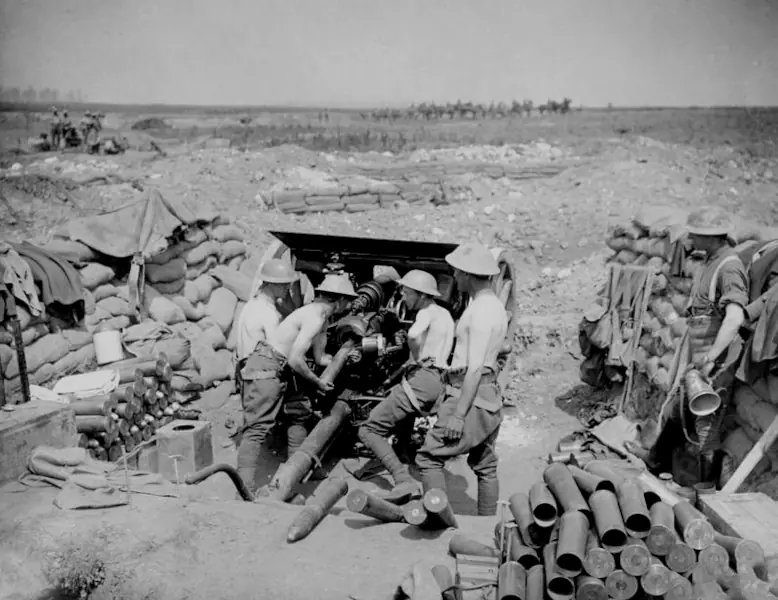
QF 18 pounder gun, Battle of Pozieres Ridge, 30 July 1916
Photo: Imperial War Museums, Q 4066
Sources and Resources
Derek Driscoll's original pages
A Short Active Service History of 240 Bde R.F.A. (T)
The above page as a PDF file
4 Officers In Trench
A Sub, A Bty 240 Bde RFA (T)
Brigade Photos
D sub somewhere in Belgium
Hill Top Farm
Hill Top Farm Shack
Sgts Mess Spring 1917
Officers, St. Ouen
Officers Mess
The Bristol Gunners
The Bristol Gunners 1908-1920
Other Sources
240 Brigade, Royal Field Artillery (Wartime Memories Project)
A-240 1st Gloucester Battery, 1st South Midland Brigade R.F.A. (T) (Imperial War Museums) - A diary of some of its experiences
An Outline of the War History of the 240th (1st South Midland: Gloucestershire) Brigade, R.F.A. (T) by F. S. Gedye
Bound history of the 240th Brigade (1st South Midland Brigade) RFA, 1914-1918 (Imperial War Museums) - A summary of the history of the Brigade
Gloucestershire Volunteer Artillery (Wikipedia)
The 48th (South Midland) Division 1908-1919 by K. W. Mitchinson, published 15th October 2017.

